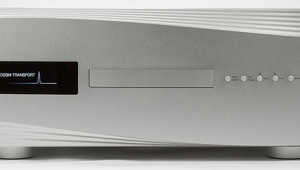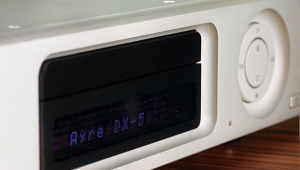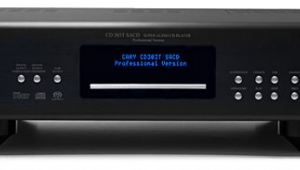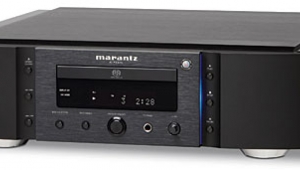| Columns Retired Columns & Blogs |
Ayre C-5xe universal disc player John Atkinson April 2009
John Atkinson wrote about the Ayre C-5xe in April 2009 (Vol.32 No.4):
The Ayre Acoustics C-5xe universal player ($5950) has been my primary reference for CD playback since I purchased it three years ago, I used it for my primary comparisons with the Meridian 808i.2, with the players' levels matched at 1kHz to within 0.1dB. As the Ayre's sole digital output is AES/EBU on an XLR jack and the Meridian has only coaxial and optical S/PDIF data inputs, I fed the Ayre's digital data to a dCS 972 digital format converter, set to do nothing other than pass the incoming data to its outputs. I connected the dCS's coaxial output to one of the Meridian 808i.2's coaxial inputs with a short length of Stereovox XV2 S/PDIF cable. The Ayre's reconstruction filter was set to Listen, which trades off a premature top-octave response droop against better time-domain performance.
For my first comparison I used Robert Silverman's performance of Liszt's Liebestraum, from Editor's Choice (CD, Stereophile STPH015-2). The result wasn't what I was expecting from my prior auditioning of this track with the CD played in the Meridian, in that the piano now sounded a touch more bright and not as palpable. The Ayre was clearly preferable. I checked the setting of the dCS. Ah...I'd forgotten to change the 972's output frequency from 96kHz to 44.1kHz, meaning that the dCS was upsampling the CD data before sending it to the Meridian, an additional variable that worked against the English player. I tried again.
Now it was not so clear-cut. After many A/B comparisons, if I had to swear, the Meridian produced a better sense of the piano in the space where I had made the recording, the Ayre a more robust midrange that pushed the piano image forward a little.
Next up were the three Gershwin Preludes from Editor's Choice, arranged for piano and chamber orchestra. Again the piano image was set a little farther back in the acoustic via the Meridian. But the percussion instruments—particularly the snare drum in the second Prelude and the tambourine in the third—sounded better defined through the 808i.2. By contrast, the Ayre tended to run the tambourine jingles into one another a little more.
Ultimately, as much as I have appreciated the Ayre's playback of CDs, it was outpointed by the Meridian. Recorded soundstages were more expansive, yet without individual images within those stages becoming bloated or more diffuse. The relationships between the instruments and the surrounding space on Jerome Harris's arrangement of Duke Ellington's "The Mooche," also on Editor's Choice, sounded slightly blurred through the Ayre, slightly better delineated via the Meridian—not an enormous difference, but still an important one, I feel. In the words of the inimitable Sam Tellig channeling Gertude Stein, with the Meridian, there was more "there" there.
At the 2009 Consumer Electronics Show last January, Ayre announced that they were offering an upgrade service by which both their C-5xe and CX7-e players could be retrofitted with minimum-phase digital reconstruction filters, one of which is similar to Meridian's apodizing filter. I'm sending my sample of the C-5xe back to the factory for the upgrade, so a rematch with the 808i.2 lies in the future.—John Atkinson
- Log in or register to post comments




































